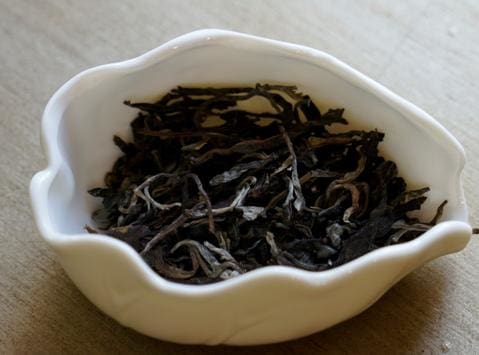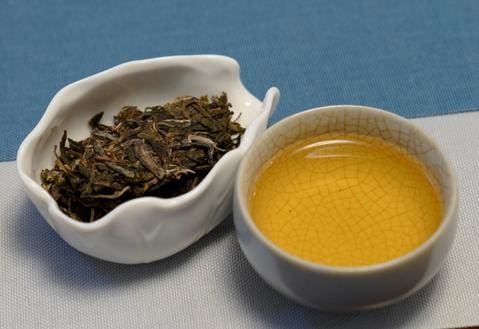Last week, we discussed what to expect when you venture into the exotic territory of pu’erh tasting. Unlike other forms of tea, it is pu’erh that usually has the most impressive endurance, lasting through many infusions. But not only that, it’s the transition, the changes from infusion to infusion that really make these teas special.
infusion to infusion that really make these teas special.
To help readers walk through this a little better, we decided to turn theory into reality, offering a guided tour through the tasting of one of our very own pu’erhs, the treasured Lao Man’E Ancient Tree, a raw pu’erh. This particular tea has an outstanding reputation for quality, but as a result of its deserved fame, this has lead to a surge in misleading blends, posing as copycats and fakes. We can assure you that our Lao Man’E is 100% authentic, as it was directly sourced by us.
For the curious, here’s how this tea session unfolded:
- Method: Gongfu
-
Instruments:
- Session One: 100mL clay teapot and Jian Zhan tea cup
- Session Two: Clay gaiwan
-
Temperature:
- Teapot: 205°F (96°C)
- Gaiwan: 210°F (99°C)
-
Amount of Tea Leaves:
- Teapot: 4g
- Gaiwan: 7g
- Length of Infusion: 25-45 seconds
-
Number of Infusions:
- Teapot: 14
- Gaiwan: 20
-
Time:
- Teapot: 75 minutes
- Gaiwan: 90 minutes
We opted to use two different methods of gongfu brewing, one with a teapot and one with a gaiwan, each using slightly different ratios of tea to water and slightly different temperatures. We elected to do this to learn what kinds of differences one can expect between the two methods.
Initial Impression: The dry leaves are noticeably long, colors ranging from pale green to dark green. Upon smelling, they present with an aroma of indistinguishable stone fruit and sweet honey.

First Infusion:
Teapot: Immediately, I can detect a mild, smoky aroma, reminiscent of the smell of orchid flowers. Interestingly enough, this aroma doesn’t quite translate over to the taste where I am instead greeted with something more akin to a sharp woody note, like a cedar, paired with citrus peels. There’s a mild astringency, but it actually makes for quite a pleasant mouthfeel. I can’t quite explain it, but this infusion makes me feel like the color green. I imagine myself plucking a fresh tangerine from a tree, a lengthy bit of stem still attached, and as I inhale it, I taste this tea. When finished, within a minute, there’s a noticeable step up in energy.
Important Gaiwan Differences: The mild smoky aroma we detected with the teapot is fascinatingly different with a gaiwan, reminiscent of a sweet campfire, as if one were toasting marshmallows and baking green apples. In tasting the tea, there’s an obvious floral component that was lacking with the teapot, along the lines of honeysuckle and gardenia, but the star of the show are these delightful tropical flavors, almost like a piña colada.
Second Infusion:
Teapot: If the first infusion was like inhaling a fresh tangerine, the second infusion is more like biting into a fresh red apple. The astringency is a little more prominent in this cup, but nonetheless, it’s a sensation that still pleases the mouth. I get this feeling while I sip it, a single word comes to mind: fiery. That’s not to suggest that this tea is spicy or hot; it just invokes imagery associated with this word. Strangely, my sense of time begins to become distorted, as if time were dilating, somehow both, internally slow but externally fast.
Important Gaiwan Differences: The pleasant orange peel astringency from the first steeping of the teapot makes its appearance in the second infusion with the gaiwan, and the tropical piña colada flavor begins transitioning over to a more coconut-forward taste. A new floral aromatic also greets the nose. Unmistakably, it’s a jasmine. What’s nice about this infusion is that the texture of the tea is kind of buttery and smooth.
Third Infusion:
Teapot: With some subtle floral notes in the background, the fresh apple flavor from the previous infusion has given way to something a little more exciting. Imagine taking the apple peels, sprinkling them with cinnamon, and baking them; that’s what this cup tastes like. My mood has shifted with each infusion to light and airy, care-free, and I observe that my mind wants to both drift but also be empty, quickly pushing out any thoughts that arise, as if it is enjoying this ideational vacuum.
Important Gaiwan Differences: By the time you reach the third infusion, it is readily apparent that the gaiwan just brings out so many more floral notes than the teapot, adding a whole new dimension to this tea. In this infusion, we felt as though the jasmine remained, but it was also complemented by the lovely fragrance of blooming lilacs. This infusion is starting to become noticeably sweeter as well, like a spring orange blossom honey.
Fourth Infusion:
Teapot: The pu’erh is becoming noticeably fruitier. There’s a sweetness on the literal tip of the tongue that’s actually quite hard to pinpoint and describe. The flavor of apple peel is still present, but I’m now detecting a complement with wild blueberries. As I reach the bottom of the cup, I feel campfire, not the smokiness of a Lapsang but the feeling of campfire.
Important Gaiwan Differences: The jasmine aroma has become predominant, but amazingly, yet another floral aroma emerged: rose petals. Perhaps interesting, the nuttiness present in the first and second infusions has transformed into more of an almond-like taste.

Fifth and Sixth Infusions:
Teapot: This tea has officially burst into a fruity bouquet. If you take apple slices and wild blueberries, mix them with other types of berries and melon cubes, and then garnish the resulting fruit salad with a little bit of mint leaf, you’ve approached what these infusions now taste like. It’s astonishing how much flavor there can be so late in the process.
Important Gaiwan Differences: It’s hard to believe that this method of brewing really accentuates the floral qualities of this tea far more than the teapot. By the time you reach these infusions, the jasmine aroma remains strong alongside smoky orchid notes. These qualities remain fairly strong up through the eleventh infusion.
Seventh and Eighth Infusions:
Teapot: The texture of this tea has changed, and while you would expect this to signal that the tea is getting weaker, on the contrary, the texture is actually getting thicker. The liquor now has a melted butter texture to it, coating the mouth easily during each sip, leaving one feeling relaxed and emotionally warm. There are more indistinguishable floral notes in these infusions, accompanied by a honey-like sweetness reminiscent of the aroma from the dry leaves.
Ninth Infusion:
Teapot: Things get a little bizarre here. If you were to somehow take all of the flavors from all of the prior infusions and blended them together, that’s what this cup tastes like. It’s just a medley of diverse flavors, leading to the most complex taste of this tea yet.
Tenth Infusion:
Teapot: It seems that the ninth infusion was the grand finale. There’s still much to offer from this tea, as it’s beginning to taste slightly herbaceous, but the texture is at this point just starting to get thinner. Also, the complexity from the previous infusion is absent.
Important Gaiwan Differences: What makes the gaiwan especially nice for brewing this tea is that it seems to not only bring out the floral qualities of the tea more, but it does so for a longer period of time. Whereas the best infusions for the teapot seemed to occur between steepings five through eight, with the gaiwan, we’re comfortably into the tenth infusion with no sign of slowing down.
Eleventh to Fourteenth Infusions:
Teapot: With each and every infusion from here on out, the tea predictably gets thinner and the flavors weaker. It would be a mistake to dismiss these infusions altogether, as they’re still very much enjoyable, but they don’t compare to the previous infusions. Interestingly, there’s a fresh soybean flavor that has greeted the senses in these final cups.
Important Gaiwan Differences: You don’t really notice anything like this until the eighteenth infusion, and so you get much better stamina with it.
Conclusion: Wow! There’s no question that pu’erhs demand patience.

The teapot was nice insofar as it brought forward more of the fruity characteristics of this tea, but there’s little question that the gaiwan adds a whole new dimension since it elicits distinct and noticeable floral notes. These added floral notes make for an experience that the teapot is just lacking.
Similarly, with the teapot, far and away, the best infusions were throughout the middle of the tasting, from steeping five through eight, but with the gaiwan, this tea was able to maintain its strength well into its fourteenth infusion.
One important lesson here is that while you’ll still have a great tea if you choose to brew with the teapot, you’ll have an all-around even better experience using a gaiwan. It’s eye-opening what a difference a simple change in instruments can make.
A good secondary lesson, however, is that in both cases, if we would’ve tossed these leaves after just a few infusions, we would’ve sadly missed out on these experiences. At a minimum, therefore, it’s important to ensure that you’re reaching those later stages of your pu’erh, and this tea in particular is such a joy to continue to drink, suitable for an engaging conversation with a thoughtful companion.
Even though this tasting session focuses specifically on Lao Man’E, it’s important to remember that every pu’erh has treasures like this to offer when given time and attention. It’s easy to see why this tea not only has such a strong reputation, but also why more and more tea drinkers are drawn to the uniqueness of pu’erh tea in general.







Leave a comment